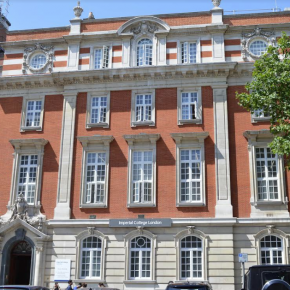
Quality engineered products for a new engineering department with Selectaglaze
Secondary glazing specialists Selectaglaze have recently carried out work at a state-of-the-art engineering facility in Imperial College London.
In 2016, Imperial College London acquired the neighbouring disused Royal Mail Post Sorting Office from the Science Museum.
As part of Royal Mail’s business consolidation, the building had been left unoccupied for a number of years after becoming surplus to their needs.
Prior to becoming part of the Royal Mail’engis real estate, yet still owned by the Science Museum, it was home to the Met Office, from 1910.
Ranked 9th in the world and 3rd in Europe, Imperial College London is frequently looking to develop its teaching and research facilities to entice the top academic brains to study there.
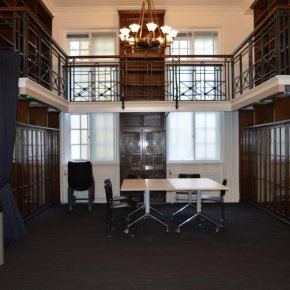
Not only does it attract top class students, researchers and teaching staff, but collaborations and donations from some of the world’s leading business men and women too.
Planning was submitted to alter this beautiful Edwardian Baroque style sorting office into the new ‘Dyson School of Design Engineering’, which was made possible by a £12million donation from the James Dyson Foundation.
The plans were to alter the building into lecture theatres, flexible working spaces, laboratories, design library, café and more. It is likely that over 500 people; both researchers’ and staff would be using the new facility.
Surrounded by Grade I and II Listed buildings including the Science Museum and The Observatory, the former sorting office had a number of period features both internally and externally, which had to be retained.
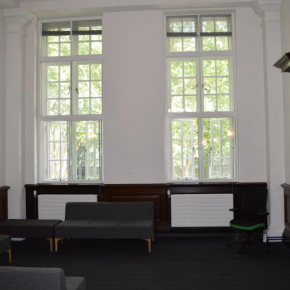
Planning was granted on the basis that all these architectural details remain. Although not Listed in its own right, it sits within the Queens Gate Conservation Area of Metropolitan Importance, so the heritage of the building had to be considered during the design process.
Architects Pascall+Watson were employed to formulate a sensitive yet practical design for the change of use of this four storey building.
As part of the plans, thought had to be given as to how to minimise carbon consumption, as well as reduce energy use and wastage in line with the College’s Environmental Policy. Imperial’s aim is to become the leading UK academic institution providing a low carbon heritage estate.
A substantial amount of heat and energy can be lost through poor performing windows and due to the planning restrictions on the new Dyson Building, the original single glazed windows of all shapes and sizes had to be retained.
Therefore, Pascall+Watson specified secondary glazing to improve their performance. If the secondary window is glazed with a low-E glass, U-values can be reduced to 1.8 – 1.95 and virtually all draughts eradicated. A reduction of up to 60% can be attained with effective sealing and tight fitting secondary glazing.
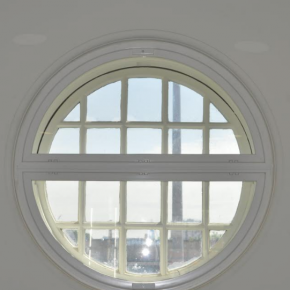
Working with Willmott Dixon and the Imperial Estates Team, discreet configurations were designed to treat over 180 windows across the building.
Over seven different types were installed to match the varying styles; large sweeping curved headed casements were treated with matching sightline Series 41 side hung casements, tall traditional box sash windows were treated with Series 20 and 25 vertical sliding units, along with a tricky installation of high-level stairwell port hole windows at the top of the building.
To increase energy performance further, the units were glazed with 6.8 low-E laminate glass.
On the façade overlooking the service area of the Science Museum, obscurity glass was specified, to prevent distractions for the researchers and staff.
The windows overlooking the busy thoroughfares of Exhibition Road and Imperial College Road were fitted with a cavity to provide added acoustic insulation, creating quiet conducive spaces for learning and meetings.
With lots of new and costly equipment in the labs and teaching rooms, it was decided to enhance the security glazing of the ground floor windows with Secured By Design accredited units, the Police Preferred Specification.
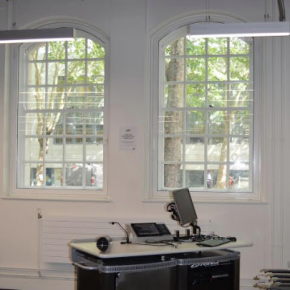
These were manufactured with specialist locking systems and key locking handles.
The new secondary glazing in this state-of-the-art engineering facility, sits perfectly in this repurposed former sorting office. The rooms are now quiet and warm, retaining the elegance of the original architectural features.
Fraser Wigley, Imperial College London Estates Team, commented: “It is a distinctive building, in a prominent location, with a wide variety of window shapes of character. It was a challenging project to make this building suitable for its new College use, including providing both some thermal benefits and soundproofing to some degree to traffic.
“The solution was secondary glazing. Selectaglaze worked ‘invisibly’ in achieving this. They appeared, measured, then returned to install, completing their work successfully and imperceptibly within the project schedule.”
Selectaglaze has worked extensively across the growing Imperial College London Estate and installed secondary glazing in other world renowned universities throughout London and the UK.
With their lengthy history working in educational establishments and the understanding of their requirements, Selectaglaze creates discreet and high performing treatments to enhance the environment for all using the buildings.
Contact:
Selectaglaze,
Alban Park,
Hatfield Road,
St. Albans,
Hertfordshire,
AL4 0JJ
Phone: 01727 837271
Visit Supplier's page
Latest news

30th April 2025
Digital Construction Week announces seminar programme for its landmark 10th edition
Digital Construction Week (DCW) returns to ExCeL London on 4 – 5 June 2025 with its most impactful programme yet. It brings together the best and brightest from across AECO, for two days of practical learning and idea sharing.
Posted in Articles, Building Industry Events, Building Industry News, Building Products & Structures, Building Services, Building Systems, Exhibitions and Conferences, Information Technology, news, Restoration & Refurbishment, Retrofit & Renovation, Seminars
29th April 2025
Senior pledges to ‘bee’ part of the solution with new biodiversity initiative
Senior Architectural Systems has installed its first on-site beehive, marking another step forward in its commitment to sustainability and biodiversity.
Posted in Articles, Building Industry News, Building Products & Structures, Building Services, Curtain Walling, Doors, Glass, Glazing, Innovations & New Products, news, Restoration & Refurbishment, Retrofit & Renovation, Sustainability & Energy Efficiency, Walls, Windows
29th April 2025
West Fraser range delivering key benefits for South-East carpentry company
An experienced carpenter and building site manager who has recently set up his own company is using high performance panel products from the West Fraser range.
Posted in Articles, Building Industry News, Building Products & Structures, Building Systems, Case Studies, Garden, Restoration & Refurbishment, Retrofit & Renovation, Sustainability & Energy Efficiency, Timber Buildings and Timber Products
29th April 2025
CPD Courses Available Online From Ecological Building Systems
Ecological Building Systems, a leading supplier of natural building products for sustainable construction, has revealed its comprehensive CPD programme for the year ahead.
Posted in Articles, Building Industry Events, Building Industry News, Building Products & Structures, Building Services, Continuing Professional Development (CPD's), Information Technology, Innovations & New Products, Insulation, Restoration & Refurbishment, Retrofit & Renovation, Seminars, Sustainability & Energy Efficiency, Training, Walls, Waste Management & Recycling
 Sign up:
Sign up: